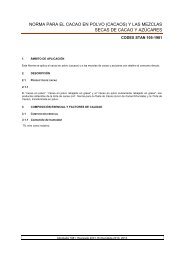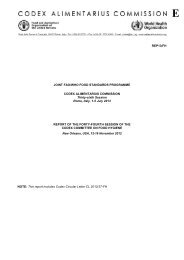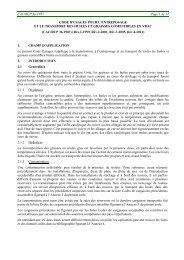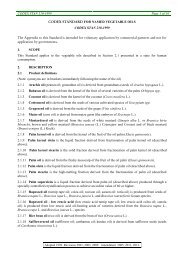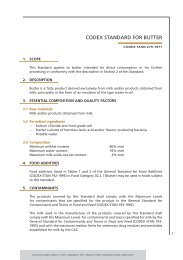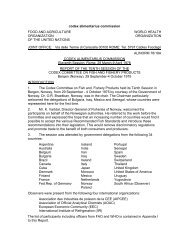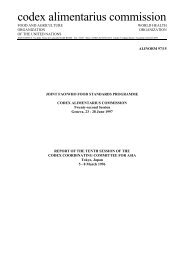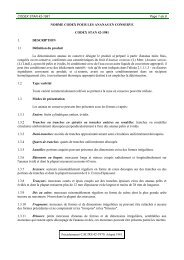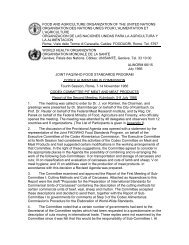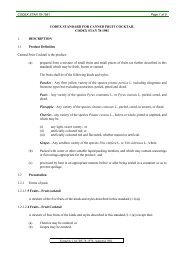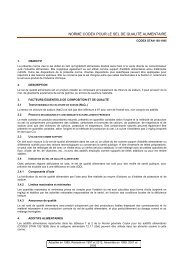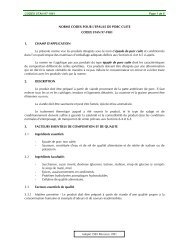codex alimentarius commission FOOD AND AGRICULTURE ...
codex alimentarius commission FOOD AND AGRICULTURE ...
codex alimentarius commission FOOD AND AGRICULTURE ...
You also want an ePaper? Increase the reach of your titles
YUMPU automatically turns print PDFs into web optimized ePapers that Google loves.
* Calculated on the basis of 370 calories per 100 grammes.<br />
** This protein level assumes an NPU not less than 60 and a PER not less than 2.1. If these values are higher, the<br />
level of protein may be reduced accordingly (see Section 1).<br />
*** Crude fiber higher than this may be acceptable although it would require clinical testing.<br />
Units per 100<br />
calories*<br />
Units per 100<br />
grams<br />
Vitamin A, retinal equivalent 108 mcg 400 mcg**<br />
Thiamine 80 mcg 0.3 mg<br />
Riboflavin 108 mcg 0.4 mg<br />
Niacin 1330 mcg 5.0 mg<br />
Folate 54 mcg 0.2 mg<br />
Vitamin B 12 0.54 mcg 2.0 mcg<br />
Ascorbic acid 5400 mcg 20 mg<br />
Vitamin D 108 IU 400 IU<br />
Calcium 80 mg 300 mg (as phosphate or carbonate)<br />
Iron 2.7 mg 10 mg (as food-grade compound of<br />
adequate iron availability)<br />
Iodine 28 mcg 100 mcg (as iodate or iodide)<br />
* Calculated on the basis of 370 calories per 100 grammes.<br />
** 1300 International Units as vitamin A palmitate.<br />
NOTE: Under certain local conditions, the addition of vitamin B 6 (to approximately the<br />
level of thiamine) and of alphatocopherol should be considered.<br />
The values for vitamins and minerals are considered minimal, except in the case<br />
of vitamin D, where no further increase is desirable. The excess of each vitamin added<br />
during processing should be no greater than that needed to maintain label requirements<br />
over the expected shelf-life of the product.<br />
7. <strong>FOOD</strong> ADDITIVES<br />
The use of excessive amounts of flavouring agents should be avoided. If any<br />
food additives are used, they should be those which have been cleared by the Joint<br />
FAO/WHO Expert Committee on Food Additives. The amounts used should not exceed<br />
the minimum necessary to produce the desired effect. Necessary information must be<br />
given on the label on the nature and quantities of food additives used in the product.<br />
8. ST<strong>AND</strong>ARDS <strong>AND</strong> PURITY<br />
8.1 The ingredients in the formula should meet national and/or international<br />
standards with regard to purity. The Protein Advisory Group has prescribed quality<br />
guidelines for some common ingredients.<br />
8.2 Legumes and oilseeds may frequently contain tryptic inhibitors and other<br />
undesirable factors which must be reduced by processing before use in high-protein<br />
foods. Since all toxic factors may not be eliminated by processing, it is essential that only<br />
grain legumes which are nutritionally wholesome and toxicologically safe be used.<br />
8.3 The preparation of a protein concentrate from oilseeds may require solvent<br />
extraction. Adequate procedures requiring food-grade solvents are described in the Joint<br />
FAO/WHO Expert Committee Report No. 14. It is necessary to eliminate the dangers of<br />
toxicity from solvents by using food-grade products.<br />
8.4 Cereals, oilseeds and other source materials to be used in the basic mixture may<br />
be contaminated with toxic molds. The Protein Advisory Group has reviewed this



